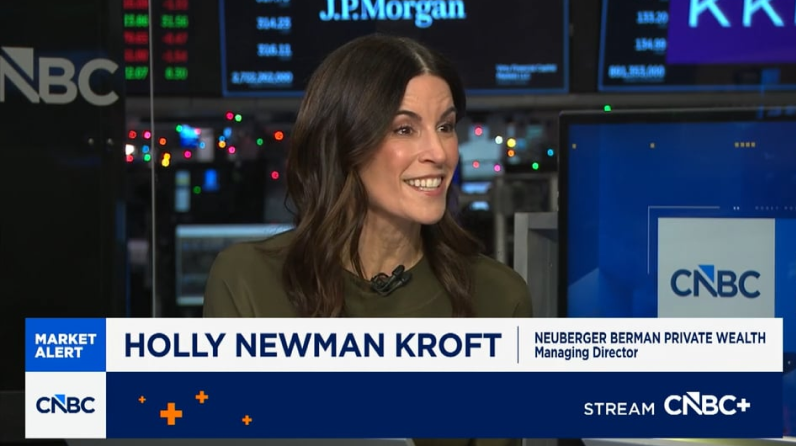

While resilience was November's theme, a challenged consumer and other potential slower growth catalysts are expected in 2024.
In Short
- Resilience was November’s theme, with the S&P 500 Index up 11.2% since its October low and the U.S. Bloomberg Aggregate Bond Index posting its best monthly price gain since the 1980s
- While the bull-bear spread hit a net bullishness of +29.2 during the month, we remain wary of nearing a “euphoric” level of market confidence
- Looking ahead to the new year, we expect a challenged consumer, continued above-target inflation, still-elevated interest rates, housing costs that hover at multidecade highs, and a softening jobs market—all potential drivers of slower growth
- Our outlook remains cautious, favoring higher-quality areas of the market across asset classes along with active management to help navigate potential future challenges
A November to Remember
After a more-challenging-than-expected start to 4Q—typically the strongest quarter of the year for the S&P 500 Index—in which all major indices gave up some of their positive returns from 1H, resilience was the theme in November, erasing four months of losses. Since its October 27 bottom, the S&P 500 Index has rallied 11.2% through November 30, with the U.S. Bloomberg Aggregate Bond Index posting its best monthly price gain since the 1980s and the Dow Jones Industrial Average hitting a fresh high for the year. With this strength in mind, the 50/50 balanced portfolio, a common asset allocation for many private clients, returned 7.7% for its strongest month since 1987. However, while outsized monthly rallies are welcome, they tend to be few and far between: The 50/50 portfolio has generated a monthly return of +7% or higher only four times since 1980.
This month’s rally in both stocks and bonds was driven by a sharp decline in yields as the 10-year U.S. Treasury yield fell from 4.93% to 4.33% over the course of November and has continued to drift lower in December. The increase in yields from August to October had increased pressure on stocks, such that the reversal in yields in November lifted almost all asset classes. While there is clearly evidence of slowing economic data globally, the pull-forward in rate-cut expectations—the CME FedWatch tool is now pricing in a March 2024 rate cut at a greater than 50% probability, up from less than 25% in early November—has been due in large part to renewed optimism about a possible soft landing. Driving this optimism, in our view, is the continued march lower in all major measures of inflation, including cooling input costs and wages.
Energy prices in particular have been falling which may reflect concerns around potential declines in economic activity. Despite OPEC+ announcing additional supply cuts, the price of oil as measured by WTI crude was down 6.3% in November; though supply could continue to be pressured by the cartel, creating an unnatural supply constraint, caution around the potential for slower demand appears to be weighing on prices. As reflected in PMI surveys, global manufacturing activity has remained weak on softer demand, with U.S. manufacturing PMI was unchanged at 46.7 last month. Indicating a contraction in manufacturing, this was the 13th consecutive month that PMI stayed below 50 and the longest such stretch since August 2000 to January 2002. While manufacturing contributes a much smaller percentage than services to U.S. GDP, the muted tone contrasts with expectations for an infrastructure- and reshoring-fueled boom following the passage of legislation including the Inflation Reduction Act, and may present a more accurate picture of where the economy is headed than backward-looking measures of strength such as the 3Q GDP print.
Are Bears Going Into Hibernation?
Looking at the market from a more technical perspective, as asset prices rose in November, volatility moved lower. The CBOE’s VIX Volatility index—often referred to as the “fear gauge”—hit a low on Black Friday not seen since January 2020. Similarly, bullish sentiment hit its highest level since late July. The bull-bear spread—a contrarian indicator highlighting the difference between investors who see the stock market going higher and those who expect a decline—hit a net bullishness level of +29.2 in November. While low volatility and bullish sentiment can be positive for equity markets, these levels can also suggest the nearing of a “euphoric” level of market confidence. We mentioned this dynamic in our July As Good as It Gets? commentary, which was soon followed by a drawdown in equities. From the S&P 500 Index’s peak on July 31, the index declined 10.28% through October 27, although, as mentioned above, this was primarily a result of the sharp rate movements experienced during that period.
Bullish Sentiment Getting Overextended?

Source: Bloomberg, American Association of Individual Investors, as of November 30, 2023.
We will continue to monitor various metrics as the year concludes and we look ahead to 2024. As mentioned above, inflation continues to cool, with personal consumption expenditures (PCE, the Federal Reserve’s preferred inflation metric) up 3% year-over-year, down from 3.4% the prior month and 5.4% at the start of the year. While we believe this move is meaningful and shows the impact of the Fed’s restrictive policy, there remains a way to go to reach the Fed’s stated 2% target.
Ahead of the holidays, 3Q earnings season was “wrapped in a bow” with a blended EPS growth rate of 4.8% compared to an anticipated 0.3% decline. This was the first positive year-over-year growth in earnings since 3Q 2022. Eighty-two percent of S&P 500 companies reported actual EPS above consensus, which was above both the five- and 10-year averages of 77% and 74%, respectively. Focusing on consumer spending, the holiday shopping season seems off to a strong start. Bank of America reported that card spending per household (measured by BAC aggregated credit and debit cards) was up 2.3% on Black Friday over 2022.
As for the labor market, job openings have been on a downward trend while unemployment claims have been pushing upward. The latest JOLTS report showed its third straight monthly decline while continuing claims for unemployment surged to 1.93 million to end the month, the highest level since November 2021. The trend seen in these figures over the past few months, in our view, are finally showing signs of a cooling labor market. This could potentially be another favorable sign for the Fed as it considers possible rate cuts in 2024.
Looking Ahead to 2024
As Americans gear up for holiday season, Wall Street has begun to look ahead to 2024 with its traditional market and economic outlooks. Street consensus was surprised to the upside in 2023 by a resilient U.S. consumer, a tight post-pandemic labor market and the solid balance sheets of bellwether U.S. companies, which were able to lock in low fixed interest rates on their debt prior to Fed rate hikes that lasted longer than first anticipated.
Perhaps one of the most surprising turns of events in 2023, among many, was the strength of the “Magnificent 7,” the top stocks by market cap in the S&P 500 Index. Through the end of November, this basket of companies returned 99.3% year-to-date and drove 71% of the performance of the S&P 500 Index.
In our NB Private Wealth Solving for 2024 outlook, we touched on 10 key themes that we believe will be prominent for investors next year, including our views that:
- U.S consumers will face challenges as they continue to spend down excess savings from COVID-19 stimulus
- While the worst of inflation is behind us, it will likely remain above targets, and rates could remain elevated for longer as a result
- Although economists remain divided on whether the U.S. economy will tip into recession next year, we expect housing costs will continue to hover at multidecade highs and the job market to soften in 2024, leading to slower overall growth in the new year compared to 2023
U.S. Consumer Excess Savings Accumulation and Drawdown

Source: Bloomberg, as of October 31, 2023. Pre-pandemic trend is calculated as the 48 months leading to the first month of 2020. Excess Savings are calculated relative to the implied pre-pandemic trend. Nothing herein constitutes a prediction or projection of future events or future market behavior.
Within equities, we continue to focus on quality while acknowledging the clear divergence between the winners and losers of 2023 in terms of region (developed over emerging markets), style (growth over value) and size (large caps over small caps). We believe markets with a greater degree of pessimism priced in are likely to perform better than those seen as priced for perfection, should growth disappoint or the cost of capital continue to rise.
In fixed income, we remain vigilant as higher rates bite into the real economy and credit defaults begin to increase. The rising supply of government bonds is affecting risk-free yields and the shape of yield curves. Meanwhile, high cash yields have created strong demand for short-maturity investments, which in turn has started to push the “sweet spot” for relative value out to intermediate maturities. We expect these trends to continue into 2024.
Portfolio Implications
Equities had a strong month across the board with growth stocks leading the charge. We have a market-weight view on equities as part of our overall neutral positioning, moving clients closer to their long-term strategic asset allocations given the ongoing economic uncertainty. Within equities, we still favor lower-beta, higher-quality names, with a neutral view on value versus growth. In this more challenging environment, we also favor looking to active management to select companies with high earnings visibility.
Fixed income also performed well for the month, with municipal bonds and long duration outperforming so far this quarter. We continue to favor credit markets, maintaining an overweight view on investment grade securities. As mentioned in previous commentaries, while cash remains attractive, clients may want to consider adding duration within their fixed income allocations. We maintain a neutral view on high yield to balance risk in portfolios as well as given recent spread-tightening that has reduced the asset class’s risk-adjusted return potential. We are neutral on emerging markets debt due to global growth fears, particularly in China.
Within private markets, in a challenged fundraising, exit and financing environment, significant opportunities exist for firms and strategies that may act as liquidity and solutions providers to help close the capital supply/demand gap and support value-added transactions. This backdrop, along with Neuberger Berman’s deep relationships and unique position within the private equity ecosystem, has translated into record levels of deal flow across our platform. We continue to see potentially compelling opportunities in secondaries, co-investments, private credit and capital solutions.
Index Returns
| Equities & FX | |||
|---|---|---|---|
| Nov-23 | QTD | YTD 2023 | |
| Major U.S. Indices | |||
| S&P 500 Index | 9.1% | 6.8% | 20.8% |
| Nasdaq Composite | 10.8% | 7.8% | 37.0% |
| Dow Jones | 9.2% | 7.8% | 10.7% |
| U.S. Size Indices | |||
| Large Cap | 9.3% | 6.7% | 20.6% |
| Mid Cap | 10.2% | 4.7% | 8.8% |
| Small Cap | 9.1% | 1.6% | 4.2% |
| All Cap | 9.3% | 6.4% | 19.6% |
| U.S. Style Indices | |||
| Large Cap Growth | 10.9% | 9.3% | 36.6% |
| Large Cap Value | 7.5% | 3.8% | 5.6% |
| Small Cap Growth | 9.1% | 0.7% | 6.0% |
| Small Cap Value | 9.0% | 2.5% | 2.0% |
| Global Equity Indices | |||
| ACWI | 9.2% | 5.9% | 16.6% |
| ACWI ex US | 9.0% | 4.5% | 10.1% |
| DM Non-U.S. Equities | 9.3% | 4.9% | 12.8% |
| EM Equities | 8.0% | 3.8% | 6.1% |
| Portfolios | |||
| 50/50 Portfolio | 7.7% | 6.1% | 12.4% |
| FX | |||
| U.S. Dollar | -3.0% | -2.5% | 0.0% |
| Fixed Income & Commodities | |||
|---|---|---|---|
| Nov-23 | QTD | YTD 2023 | |
| Major U.S. Indices | |||
| Cash | 0.4% | 0.9% | 4.5% |
| U.S. Aggregate | 4.5% | 2.9% | 1.6% |
| Munis | 6.3% | 5.4% | 4.0% |
| U.S. Munis | |||
| Short Duration (2.4 Yrs) | 2.4% | 2.6% | 2.6% |
| Intermediate Duration (4.6 Yrs) | 4.9% | 4.4% | 3.0% |
| Long Duration (8 Yrs) | 8.5% | 7.0% | 4.9% |
| U.S. Corporates | |||
| Investment Grade | 6.0% | 4.0% | 4.0% |
| High Yield | 4.6% | 3.7% | 8.9% |
| Short Duration (1.9 Yrs) | 1.2% | 1.5% | 3.4% |
| Long Duration (12.8 Yrs) | 8.6% | 4.3% | -0.9% |
| Global Fixed Income Indices | |||
| Global Aggregate | 5.0% | 3.8% | 1.5% |
| EMD Corporates | 3.7% | 2.4% | 5.3% |
| EMD Sovereigns - USD | 5.7% | 4.2% | 6.1% |
| Commodities | |||
| Commodities | -2.3% | -2.0% | -5.4% |
| Commodities ex Energy | 1.7% | 3.5% | -0.1% |
| U.S. Treasury Yields | |||
| U.S. 10-Year Yield | -0.6% | -0.2% | 0.5% |
| U.S. 2-Year Yield | -0.4% | -0.4% | 0.3% |
Source: Bloomberg, total returns as of November 30, 2023. S&P 500 Index is represented by S&P 500 Total Return Index. Nasdaq Composite NASDAQ-Composite Total Return Index. Dow Jones is represented by Dow Jones Industrial Average TR. Large Cap is represented by Russell 1000 Total Return Index. Mid Cap is represented by Russell Midcap Index Total Return. Small Cap is represented by Russell 2000 Total Return Index. All Cap is represented by Russell 3000 Total Return Index. Large Cap Growth is represented by Russell 1000 Growth Total Return. Large Cap Value is represented by Russell 1000 Value Index Total Return. Small Cap Growth is represented by Russell 2000 Growth Total Return. Small Cap Value is represented by Russell 2000 Value Total Return. ACWI is represented by MSCI ACWI Net Total Return USD Index. ACWI ex US is represented by MSCI ACWI ex USA Net Total Return USD Index. DM Non-U.S. Equities is represented by MSCI Daily TR Gross EAFE USD. EM Equities is represented by MSCI Daily TR Gross EM USD. Cash is represented by ICE BofA US 3-Month Treasury Bill Index. U.S. Aggregate is represented by Bloomberg US Agg Total Return Value Unhedged USD. Munis is represented by Bloomberg Municipal Bond Index Total Return Index Value Unhedged USD. Munis Short Duration is represented by Bloomberg Municipal Bond: Muni Short (1-5) Total Return Unhedged USD. Munis Intermediate Duration is represented by Bloomberg Municipal Bond: Muni Intermediate (5-10) TR Unhedged USD. Investment Grade is represented by Bloomberg US Corporate Total Return Value Unhedged USD. High Yield is represented by Bloomberg US High Yield BB/B 2% Issuer Cap Total Return Index Value Unhedged USD. Short Duration is represented by Bloomberg US Agg 1-3 Year Total Return Value Unhedged USD. Long Duration is represented by Bloomberg US Agg 10+ Year Total Return Value Unhedged USD. Global Aggregate is represented by Bloomberg Global-Aggregate Total Return Index Value Unhedged USD. EMD Corporates is represented by J.P. Morgan Corporate EMBI Diversified Composite Index Level. EMD Sovereigns – USD is represented by J.P. Morgan EMBI Global Diversified Composite. Commodities is represented by Bloomberg Commodity Index Total Return. Commodities ex Energy is represented by Bloomberg ExEnergy Subindex Total Return. U.S. 10-Year Yield is represented by US Generic Govt 10 Yr.


INSIGHTS
CIO Notebook: December CPI Softer but Unlikely to Change the Course

Accolades
The 2026 Forbes | SHOOK Best-In-State Wealth Management Teams list

INSIGHTS
CIO Notebook: Sluggish Job Growth Points to Steady Rates, For Now

MARKET COMMENTARY
Taking Stock of 2025

VIDEO
Holly Newman Kroft Featured on CNBC’s Money Movers December 18

VIDEO
The Kantor Group | Charles Kantor’s Year-End Reflections and Key Questions as We Head Into 2026

INSIGHTS
CIO Notebook: Dual Release of Delayed Non-Farm Payrolls Likely Supports Another Cut
INSIGHTS
Using Tax-Free Gifts for Wealth Transfer
INSIGHTS
CIO Notebook: Powell Plays the Middle as Fed Cuts Rates
MARKET COMMENTARY
Giving Thanks for Market Strength
INSIGHTS
CIO Notebook: September U.S. Non-Farm Payrolls Further Complicate the Narrative
VIDEO
Holly Newman Kroft Featured on CNBC’s Money Movers November 18
VIDEO
Plan for Peace of Mind with Our Estate Planning Organizer
IMPORTANT INFORMATION:
This material is provided for informational and educational purposes only and nothing herein constitutes investment, legal, accounting or tax advice, or a recommendation to buy, sell or hold a security. This material is general in nature and is not directed to any category of investors and should not be regarded as individualized, a recommendation, investment advice or a suggestion to engage in or refrain from any investment-related course of action. Neither Neuberger Berman nor its employees provide tax or legal advice. All information is current as of the date of this material and is subject to change without notice. The firm, its employees and advisory accounts may hold positions of any companies discussed. Any views or opinions expressed may not reflect those of the firm as a whole. Neuberger Berman products and services may not be available in all jurisdictions or to all client types. Diversification does not guarantee profit or protect against loss in declining markets. Investments in private equity are speculative and involve a higher degree of risk than more traditional investments. Investments in private equity are intended for sophisticated investors only. Unless otherwise indicated, returns shown reflect reinvestment of dividends and distributions. Indexes are unmanaged and are not available for direct investment. Investing entails risks, including possible loss of principal. Past performance is no guarantee of future results.
Portfolio positioning views expressed herein are those of Neuberger Berman’s Investment Strategy Group (ISG), which may include those of the Neuberger Berman’s Asset Allocation Committee. Asset allocation and positioning views are based on a hypothetical reference portfolio. ISG analyzes market and economic indicators to develop asset allocation strategies. ISG works in partnership with the Office of the CIO. ISG also consults regularly with portfolio managers and investment officers across the firm. The Asset Allocation Committee is comprised of professionals across multiple disciplines, including equity and fixed income strategists and portfolio managers. The Asset Allocation Committee reviews and sets long-term asset allocation models, establishes preferred near-term tactical asset class allocations and, upon request, reviews asset allocations for large diversified mandates. Asset Allocation Committee members are polled on asset classes and the positional views are representative of an Asset Allocation Committee consensus. The views of the Asset Allocation Committee and ISG may not reflect the views of the firm as a whole and Neuberger Berman advisers and portfolio managers may take contrary positions to the views of the Asset Allocation Committee or ISG. The Asset Allocation Committee and ISG views do not constitute a prediction or projection of future events or future market behavior. Defensive positioning generally means an underweight bias on allocations to risk assets such as equities and alternatives. Positioning views may change over time without notice and actual client positioning may vary significantly. Discussion of yield characteristics or total returns of different asset classes are for illustrative purposes only. Such asset classes, such as equities and fixed income, may have significantly different overall risk-return characteristics which should be consider before investing.
The information in this material may contain projections, market outlooks or other forward-looking statements regarding future events, including economic, asset class and market outlooks or expectations, and is only current as of the date indicated. There is no assurance that such events, outlook and expectations will be achieved, and actual results may be significantly different than that shown here. The duration and characteristics of past market/economic cycles and market behavior, including any bull/bear markets, is no indication of the duration and characteristics of any current or future be market/economic cycles or behavior. Information on historical observations about asset or sub-asset classes is not intended to represent or predict future events. Historical trends do not imply, forecast or guarantee future results. Information is based on current views and market conditions, which will fluctuate and may be superseded by subsequent market events or for other reasons.
Discussions of any specific sectors and companies are for informational purposes only. This material is not intended as a formal research report and should not be relied upon as a basis for making an investment decision. The firm, its employees and advisory accounts may hold positions of any companies discussed. Nothing herein constitutes a recommendation to buy, sell or hold a security. It should not be assumed that any investments in securities, companies, sectors or markets identified and described were or will be profitable. Investment decisions and the appropriateness of this content should be made based on an investor's individual objectives and circumstances and in consultation with his or her advisors.
Neuberger Berman Investment Advisers LLC is a registered investment adviser.
The “Neuberger Berman” name and logo are registered service marks of Neuberger Berman Group LLC.